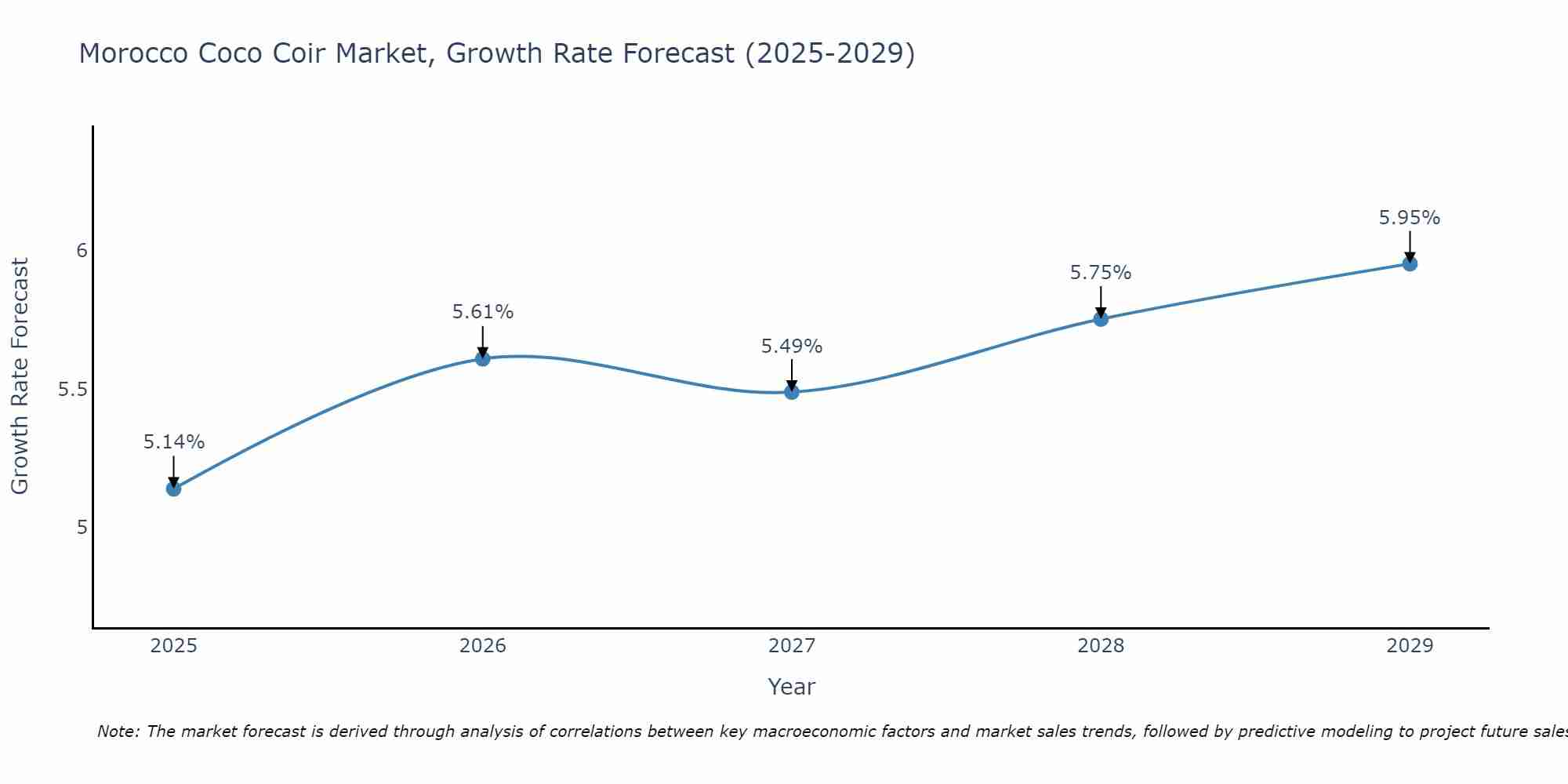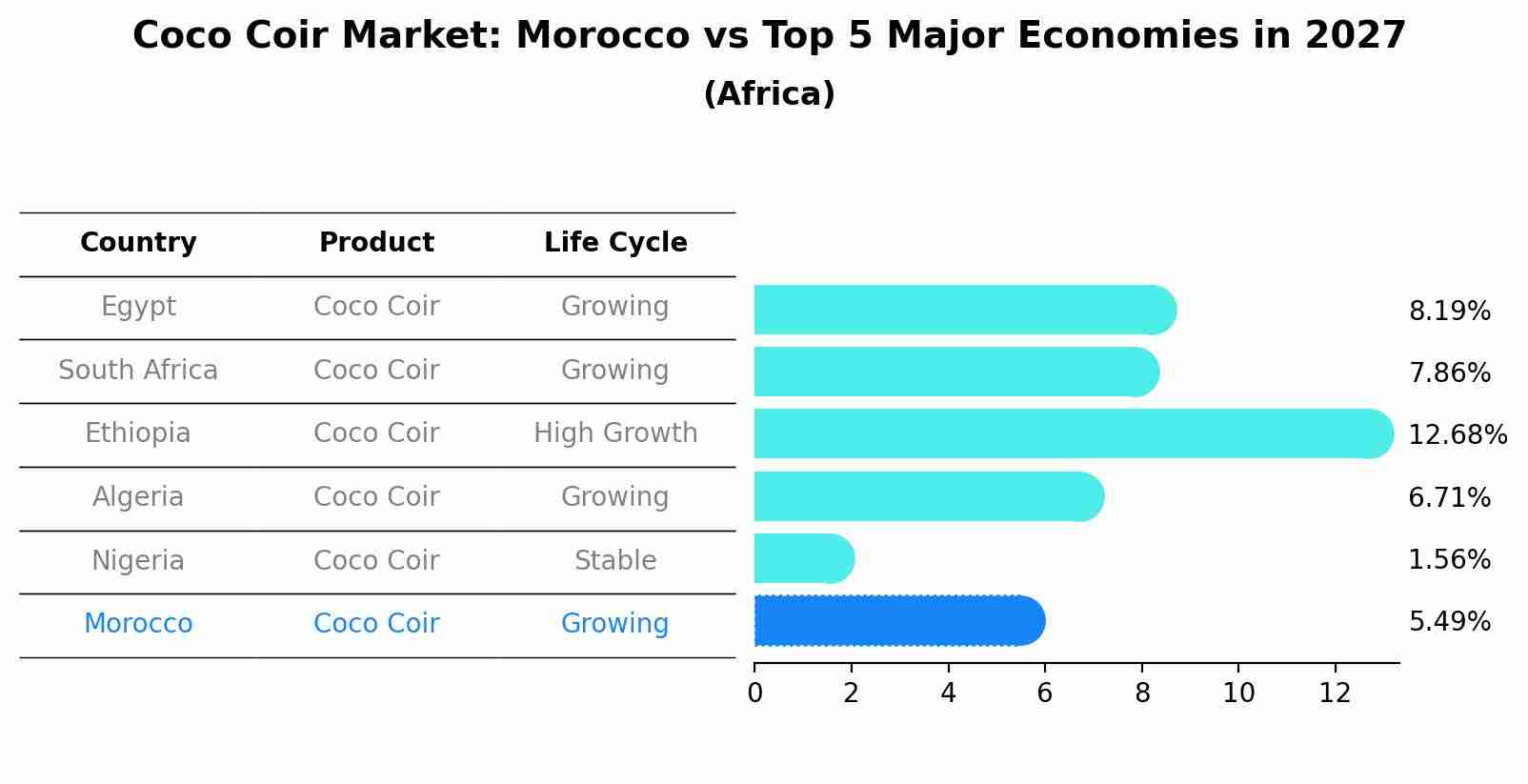Morocco Coco Coir Market Outlook | COVID-19 IMPACT, Analysis, Companies, Forecast, Value, Share, Revenue, Industry, Growth, Trends & Size
| Product Code: ETC373733 | Publication Date: Aug 2022 | Updated Date: Jul 2025 | Product Type: Market Research Report | |
| Publisher: 6Wresearch | Author: Sachin Kumar Rai | No. of Pages: 75 | No. of Figures: 35 | No. of Tables: 20 |
Morocco Coco Coir Market Size Growth Rate
The Morocco Coco Coir Market is projected to witness mixed growth rate patterns during 2025 to 2029. Commencing at 5.14% in 2025, growth builds up to 5.95% by 2029.

Coco Coir Market: Morocco vs Top 5 Major Economies in 2027 (Africa)
By 2027, the Coco Coir market in Morocco is anticipated to reach a growth rate of 5.49%, as part of an increasingly competitive Africa region, where Egypt remains at the forefront, supported by South Africa, Ethiopia, Algeria and Nigeria, driving innovations and market adoption across sectors.

Morocco Coco Coir Market Synopsis
The Morocco Coco Coir Market is experiencing steady growth due to the increasing demand for sustainable and eco-friendly growing mediums in the agriculture and horticulture sectors. Coco coir, made from coconut husks, is valued for its excellent water retention and nutrient-holding properties, making it an ideal alternative to traditional soil-based mediums. The market is driven by the rising awareness among farmers and gardeners about the benefits of coco coir, such as improved plant growth and reduced water usage. Additionally, the government`s initiatives to promote organic farming practices further contribute to the market growth. Key players in the Morocco Coco Coir Market include manufacturers, distributors, and suppliers who are focusing on product innovation and expanding their distribution networks to capitalize on the growing demand.
Morocco Coco Coir Market Trends
The Morocco Coco Coir market is experiencing a steady growth trajectory driven by increasing awareness about the benefits of using sustainable and eco-friendly growing mediums. The demand for coco coir products is rising due to its excellent water retention and aeration properties, making it an ideal choice for use in agriculture, horticulture, and landscaping. Additionally, the shift towards organic farming practices and the growing trend of urban gardening are further fueling the market growth. Key players in the Morocco Coco Coir market are focusing on product innovation, quality enhancement, and expanding their distribution networks to cater to the increasing demand. Overall, the market is expected to continue its growth momentum in the coming years as more consumers recognize the environmental and agricultural advantages of using coco coir.
Morocco Coco Coir Market Challenges
In the Morocco Coco Coir Market, some challenges include limited awareness and understanding of the benefits of coco coir among potential users, which impacts demand. Inconsistent quality standards and lack of proper certification processes also hinder the market`s growth. Additionally, the high initial investment required for coco coir production and processing facilities poses a barrier for new entrants. Fluctuations in raw material prices and transportation costs further add to the challenges faced by players in the market. Addressing these obstacles will be crucial for the sustainable development and expansion of the Morocco Coco Coir Market.
Morocco Coco Coir Market Investment Opportunities
The Morocco Coco Coir Market presents promising investment opportunities due to the increasing demand for sustainable and eco-friendly agricultural products. Coco coir, a natural fiber derived from coconut husks, is valued for its water retention and nutrient-rich properties, making it an ideal growing medium for crops. Investors can explore opportunities in coco coir production, processing facilities, and distribution networks to cater to the growing demand from the agriculture and horticulture sectors. Additionally, the rising awareness of environmental sustainability and the shift towards organic farming practices further enhance the market potential for coco coir products in Morocco. With a strategic focus on quality control, innovation, and market expansion, investors can capitalize on the growth prospects offered by the Morocco Coco Coir Market.
Jordan Agar Market Government Policies
The Moroccan government has not implemented specific policies targeted towards the Coco Coir market as of yet. However, the overall agricultural policies in Morocco, such as subsidies, support for modernization, and sustainable agricultural practices, indirectly impact the Coco Coir market. The government has been focusing on promoting sustainable agriculture and improving soil fertility, which could potentially drive the demand for organic growing mediums like Coco Coir. Additionally, Morocco has been actively working towards increasing agricultural exports, which could present opportunities for the Coco Coir industry to expand its market reach. Overall, while there are no direct policies targeting Coco Coir, the government`s broader agricultural initiatives could have a positive impact on the market`s growth and development in the country.
Morocco Coco Coir Market Future Outlook
The Morocco Coco Coir Market is expected to show promising growth in the coming years due to increasing awareness about sustainable agriculture practices and the rising demand for organic products. With a growing emphasis on environmentally friendly alternatives to traditional soil mediums, coco coir, being a renewable and biodegradable product, is gaining traction among farmers and gardeners. The market is likely to benefit from government initiatives supporting the agriculture sector and the ongoing trend towards organic farming. Additionally, the versatility of coco coir in various applications, such as hydroponics, landscaping, and soil conditioning, will further drive market expansion. Overall, the Morocco Coco Coir Market is poised for steady growth and opportunities for market players to innovate and capitalize on the increasing demand for eco-friendly agricultural inputs.
Key Highlights of the Report:
- Morocco Coco Coir Market Outlook
- Market Size of Morocco Coco Coir Market, 2021
- Forecast of Morocco Coco Coir Market, 2031
- Historical Data and Forecast of Morocco Coco Coir Revenues & Volume for the Period 2018 - 2031
- Morocco Coco Coir Market Trend Evolution
- Morocco Coco Coir Market Drivers and Challenges
- Morocco Coco Coir Price Trends
- Morocco Coco Coir Porter's Five Forces
- Morocco Coco Coir Industry Life Cycle
- Historical Data and Forecast of Morocco Coco Coir Market Revenues & Volume By Product for the Period 2018 - 2031
- Historical Data and Forecast of Morocco Coco Coir Market Revenues & Volume By Coco Coir Grow Bags for the Period 2018 - 2031
- Historical Data and Forecast of Morocco Coco Coir Market Revenues & Volume By Bales for the Period 2018 - 2031
- Historical Data and Forecast of Morocco Coco Coir Market Revenues & Volume By Coir Material for the Period 2018 - 2031
- Historical Data and Forecast of Morocco Coco Coir Market Revenues & Volume By Open Tops for the Period 2018 - 2031
- Historical Data and Forecast of Morocco Coco Coir Market Revenues & Volume By Blends & Loose Substrate for the Period 2018 - 2031
- Historical Data and Forecast of Morocco Coco Coir Market Revenues & Volume By Others for the Period 2018 - 2031
- Historical Data and Forecast of Morocco Coco Coir Market Revenues & Volume By Application for the Period 2018 - 2031
- Historical Data and Forecast of Morocco Coco Coir Market Revenues & Volume By Rope & Cordage for the Period 2018 - 2031
- Historical Data and Forecast of Morocco Coco Coir Market Revenues & Volume By Coco Nets & Twines for the Period 2018 - 2031
- Historical Data and Forecast of Morocco Coco Coir Market Revenues & Volume By Stitched Mats for the Period 2018 - 2031
- Historical Data and Forecast of Morocco Coco Coir Market Revenues & Volume By Coconut Meals for the Period 2018 - 2031
- Historical Data and Forecast of Morocco Coco Coir Market Revenues & Volume By Husk for the Period 2018 - 2031
- Historical Data and Forecast of Morocco Coco Coir Market Revenues & Volume By Others for the Period 2018 - 2031
- Historical Data and Forecast of Morocco Coco Coir Market Revenues & Volume By Consumer for the Period 2018 - 2031
- Historical Data and Forecast of Morocco Coco Coir Market Revenues & Volume By Green Houses for the Period 2018 - 2031
- Historical Data and Forecast of Morocco Coco Coir Market Revenues & Volume By Sellers for the Period 2018 - 2031
- Morocco Coco Coir Import Export Trade Statistics
- Market Opportunity Assessment By Product
- Market Opportunity Assessment By Application
- Market Opportunity Assessment By Consumer
- Morocco Coco Coir Top Companies Market Share
- Morocco Coco Coir Competitive Benchmarking By Technical and Operational Parameters
- Morocco Coco Coir Company Profiles
- Morocco Coco Coir Key Strategic Recommendations
Frequently Asked Questions About the Market Study (FAQs):
- Single User License$ 1,995
- Department License$ 2,400
- Site License$ 3,120
- Global License$ 3,795
Search
Thought Leadership and Analyst Meet
Our Clients
Related Reports
- Canada Oil and Gas Market (2026-2032) | Share, Segmentation, Value, Industry, Trends, Forecast, Analysis, Size & Revenue, Growth, Competitive Landscape, Outlook, Companies
- Germany Breakfast Food Market (2026-2032) | Industry, Share, Growth, Size, Companies, Value, Analysis, Revenue, Trends, Forecast & Outlook
- Australia Briquette Market (2025-2031) | Growth, Size, Revenue, Forecast, Analysis, Trends, Value, Share, Industry & Companies
- Vietnam System Integrator Market (2025-2031) | Size, Companies, Analysis, Industry, Value, Forecast, Growth, Trends, Revenue & Share
- ASEAN and Thailand Brain Health Supplements Market (2025-2031) | Strategy, Consumer Insights, Analysis, Investment Trends, Opportunities, Growth, Size, Share, Industry, Revenue, Segments, Value, Segmentation, Supply, Forecast, Restraints, Outlook, Competition, Drivers, Trends, Demand, Pricing Analysis, Competitive, Strategic Insights, Companies, Challenges
- ASEAN Bearings Market (2025-2031) | Strategy, Consumer Insights, Analysis, Investment Trends, Opportunities, Growth, Size, Share, Industry, Revenue, Segments, Value, Segmentation, Supply, Forecast, Restraints, Outlook, Competition, Drivers, Trends, Demand, Pricing Analysis, Competitive, Strategic Insights, Companies, Challenges
- Europe Flooring Market (2025-2031) | Outlook, Share, Industry, Trends, Forecast, Companies, Revenue, Size, Analysis, Growth & Value
- Saudi Arabia Manlift Market (2025-2031) | Outlook, Size, Growth, Trends, Companies, Industry, Revenue, Value, Share, Forecast & Analysis
- Uganda Excavator, Crane, and Wheel Loaders Market (2025-2031) | Strategy, Consumer Insights, Analysis, Investment Trends, Opportunities, Growth, Size, Share, Industry, Revenue, Segments, Value, Segmentation, Supply, Forecast, Restraints, Outlook, Competition, Drivers, Trends, Demand, Pricing Analysis, Competitive, Strategic Insights, Companies, Challenges
- Rwanda Excavator, Crane, and Wheel Loaders Market (2025-2031) | Strategy, Consumer Insights, Analysis, Investment Trends, Opportunities, Growth, Size, Share, Industry, Revenue, Segments, Value, Segmentation, Supply, Forecast, Restraints, Outlook, Competition, Drivers, Trends, Demand, Pricing Analysis, Competitive, Strategic Insights, Companies, Challenges
Industry Events and Analyst Meet
Whitepaper
- Middle East & Africa Commercial Security Market Click here to view more.
- Middle East & Africa Fire Safety Systems & Equipment Market Click here to view more.
- GCC Drone Market Click here to view more.
- Middle East Lighting Fixture Market Click here to view more.
- GCC Physical & Perimeter Security Market Click here to view more.
6WResearch In News
- Doha a strategic location for EV manufacturing hub: IPA Qatar
- Demand for luxury TVs surging in the GCC, says Samsung
- Empowering Growth: The Thriving Journey of Bangladesh’s Cable Industry
- Demand for luxury TVs surging in the GCC, says Samsung
- Video call with a traditional healer? Once unthinkable, it’s now common in South Africa
- Intelligent Buildings To Smooth GCC’s Path To Net Zero


















